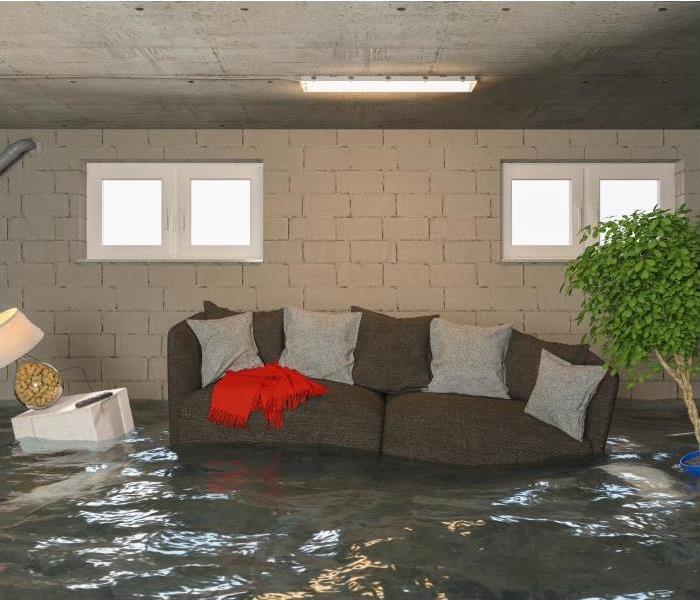When the Water Recedes: Steps to Take After a Flood
5/22/2023 (Permalink)
The power of water knows no bounds. Whatever the origin, a flood in your home or business is a disaster that requires a fast and expert response. The recovery process is just that – a process that begins with assessing the situation, clearing trash and debris, drying out the space, and doing water damage remediation work. Water damage repair work may vary widely in nature and scope depending on the building and the severity of the flooding. Expert residential repairs are necessary, so you and your family can return to a safe, mold-free environment. Commercial water damage cleanup gets your business running while ensuring the indoor environment is healthy for all staff members and visitors. So, whatever the nature of the flooded building, any flooding demands immediate action from a water damage repair service from SERVPRO of East Nashville.
The 411 on Water Damage Remediation
Whether water comes in through a severely damaged roof or blows in through shattered windows, or comes in through doors as flood waters rise in a storm, your home or business needs to be cleaned out and dried out as soon as possible after a disastrous flooding event. Waterlogged materials quickly become a growth medium for mildew and mold. Metal may begin to rust. Wood and laminates may start to rot. These are problems an emergency water damage restoration company can solve.
The actual extent of the water damage may take time to be noticeable. Consider how easily water flows through tiny cracks beneath cabinets and baseboards. A minor "flood" can be fixed by removing standing water and drying damp surfaces with a fan or paper towels. But that might not prevent further water damage and mold. A water damage repair service will cover hidden water damage and dampness, leading to mold and mildew growth. The water damage remediation process varies for each specific case, but the general steps are similar.
Steps to Take After Flood Damage
Most of the following best practices apply to commercial and residential flooding scenarios. Of course, you should always call in a water damage remediation specialist instead of trying to clean up and sanitize independently.
1 – Take care of yourself and others first
People and pets must be taken care of before any assessment or damage removal work occurs. But, after that, you want to act quickly because water damage can quickly lead to mildew, mold, and rot.
2 – Call your insurance agent
While you wait for their answers, take photos of the property to document everything damaged or destroyed. Wait to attempt a detailed inspection. In fact, you should turn over responsibility for the inspection to your insurance agent.
3 – Contact a building inspector or structural engineer
When inspecting your building or house to review the damage, you should wait to confirm that the electrical power and gas lines are off. This advice mainly applies to any significant flooding. But storms that cause water damage also break gas lines and knock down live power lines. Never guess that the gas and power are cut. A severe storm may have caused enough structural damage that your home or business is unsafe to enter.
4 – Get utilities restored
This may be a prerequisite to clearing the standing water and drying out the flooded space. This depends on how serious the flooding event was. If the event was local, like a burst pipe flooding your basement, it should only take a few days. Regional flooding may leave your property without power for a week or longer.
5 – Clear out and dry out
This is a two-part procedure best carried out by specialists. The first part involves removing any standing water from the home. A water damage repair service will use fans, vacuums, or pumps to remove the water. The next step is to dry out the interior as much as possible, often using fans or dehumidifiers. Items in the structure must either be removed to air out or disposed of. Remember that mold and mildew can start to grow in as little as 8 hours. Anything waterlogged, including carpeting, furniture, and drywall, must be removed during the water damage remediation process.
6 – Clean Up
This is the final stage of preparing the affected property for renovation. Like a few other steps, the details on how to clean up depending on whether a home or a commercial structure is involved. In a house, throw out any food that might have been affected by flood waters and lack of refrigeration. The exact nature of the cleanup will also depend on the event that caused flood damage. Debris from a partly collapsed roof, a fallen tree, and broken windows may all need to be removed.
That is how some processes work and what a water damage restoration company in Nashville would do. Proper flood damage repair work is rarely a good DIY project.
When a Flood Hits, Call on Experts
When a flood strikes and storm damage waterlogs your home or business, you need expert water damage remediation. Removing the water, assessing the damage, drying and cleaning the area, and removing waterlogged materials – are tasks best left to the emergency water damage repair pros at SERVPRO. If you suffered flood damage at your home or business, call us at 615-868-5324 to address the problem.



 24/7 Emergency Service
24/7 Emergency Service
